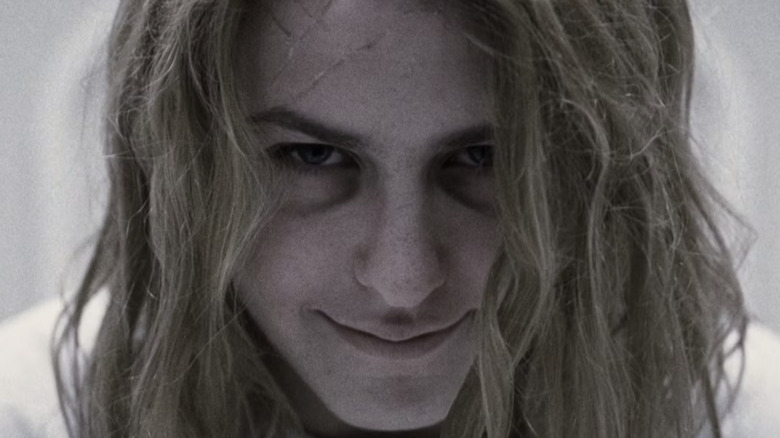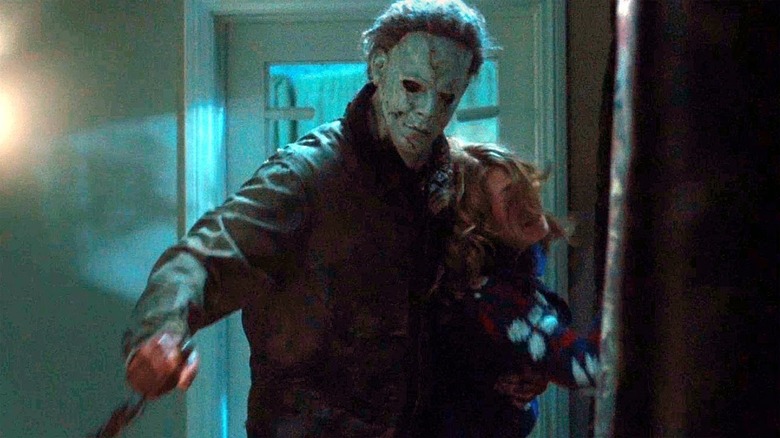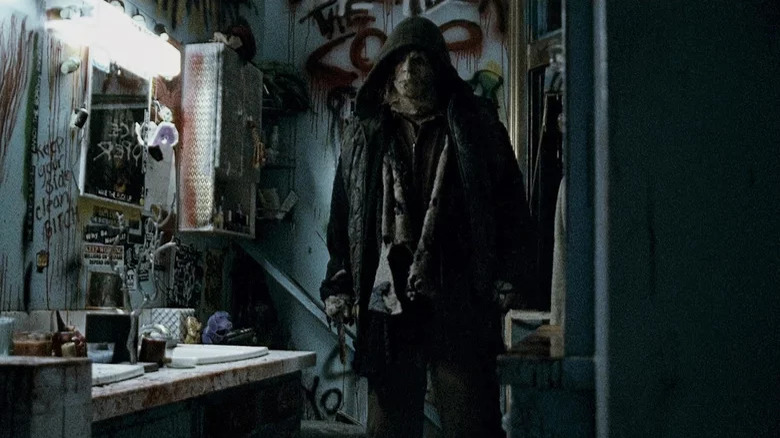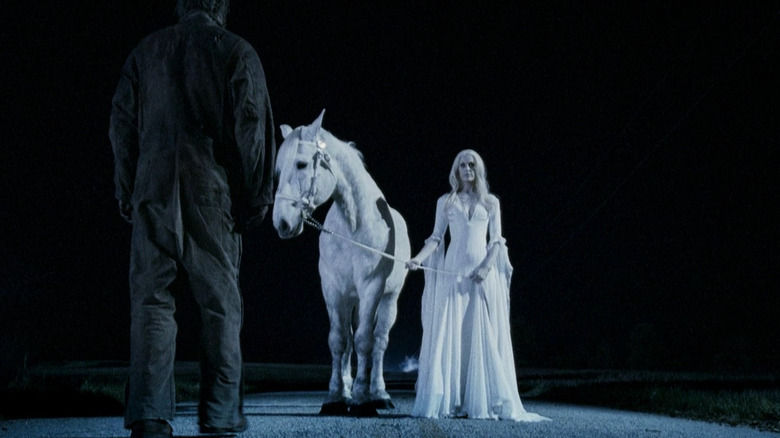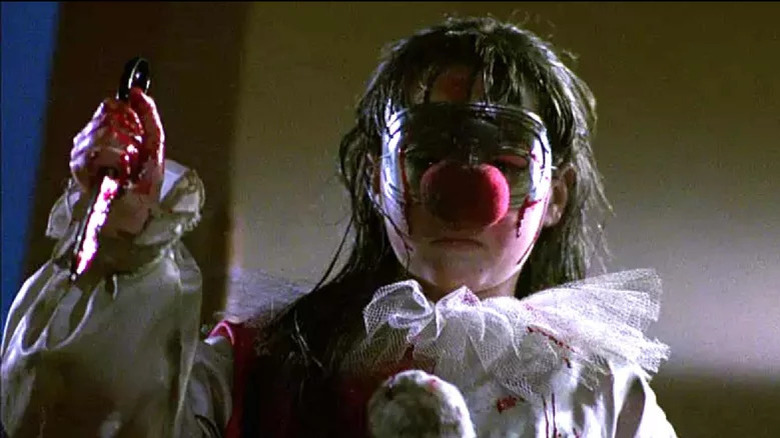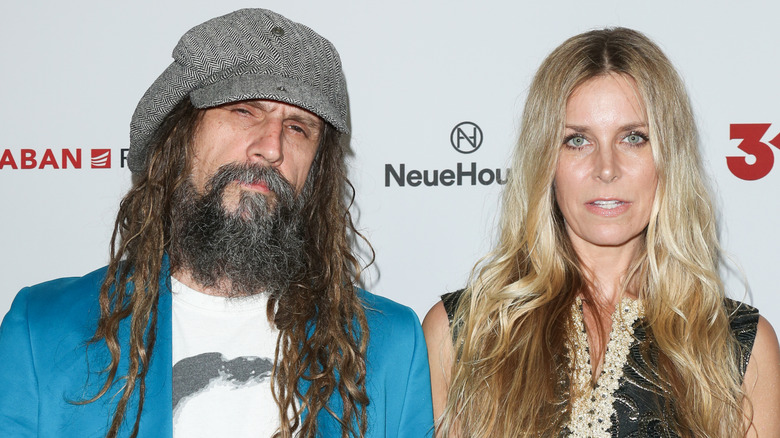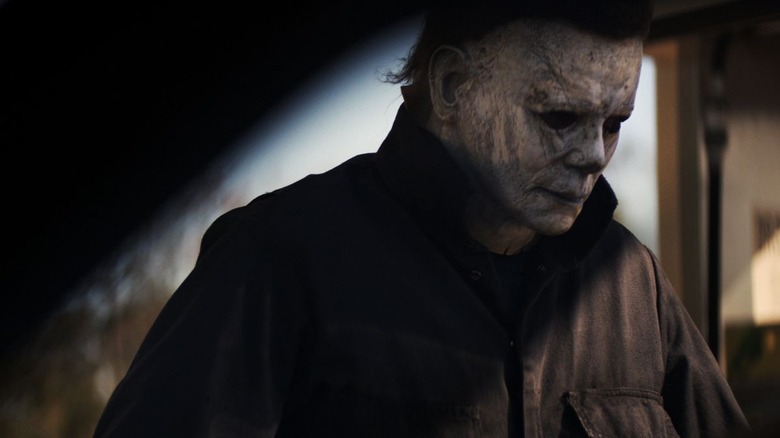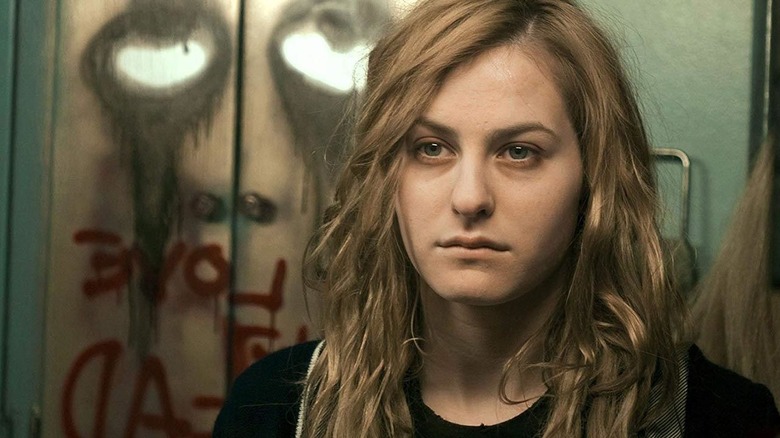Rob Zombie's Halloween 2 Ending Explained: Love Hurts, Love Scars
Don't let Rotten Tomatoes or IMDB fool you, Rob Zombie's "Halloween 2" is one of the best offerings of its franchise. It's certainly a step up from its predecessor, Zombie's 2007 remake of the original 1978 John Carpenter classic, "Halloween." That film was a compromised one — Zombie admitted to /Film back in 2009 that it was, "50% me, 50% John Carpenter." Granted, this was more out of his own love for the original than anything else; he described it as "lodged in [his] brain."
With the sequel, Zombie got to make "Halloween" his own, taking the franchise into new territory. It might well be the most character-driven of any "Halloween" movie (to the point that the slasher moments with Michael Myers feel perfunctory) and it's definitely the most surreal. Its gnarly and unhinged 2-hour runtime all leads up to the most bloody and tragic ending in "Halloween" history. What does all of that suffering add up to in the end?
What you need to remember about the plot of Halloween 2
Though "Halloween" has always played fast and loose with continuity (read the convoluted watch order here), Zombie's movies are their own thing. His first basically retold the original film but with an extended prologue showing Michael's childhood in more detail. There's one other big difference, tied into the new beginning: Michael (Tyler Mane) and Laurie Strode (Scout Taylor-Compton) are brother and sister from the get-go (the sibling angle wasn't present in Carpenter's original movie). The infant Angel Myers was adopted by the Strodes after Michael started murdering people (including their stepfather and big sister) and was institutionalized.
This twist goes back to the first "Halloween II" (a sequel to Carpenter's); there, it was a hackneyed retcon that John Carpenter came to regret. Zombie makes that connection the heart of his duology. Unlike the 1978 original, Michael returns to Haddonfield specifically to reunite with his sister and kills Laurie's adoptive parents.
"Halloween 2" is about the fallout of that reunion, one or two years later (in the theatrical and director's cuts, respectively). Laurie is alive, now living with her friend/fellow survivor Annie Brackett (Danielle Harris) and her father Leigh, the town's sheriff (Brad Dourif). Laurie is in therapy with Dr. Collier (Margot Kidder) and not doing great, suffering from nightmares about both dying and killing. She gets worse when she learns her birth name.
Dr. Sam Loomis (Malcolm McDowell), Michael's former psychiatrist, has published a tell-all book divulging Laurie's true identity. In Carpenter's original, Loomis (Donald Pleasence) said Michael was pure evil and it was taken at face value. In Zombie's film, he's just a hack and his riding the media circus reflects that.
Michael is presumed dead but is actually making his way back to Haddonfield. Spurred on by a vision of his late mother Deborah (Sheri Moon Zombie) and his younger self (Chase Wright Vanek), he's carving a trail of blood as he makes another go-around at connecting with Laurie.
What happened at the end of Halloween 2?
Michael kills Annie and abducts Laurie, taking her to a farmhouse shed. While there, Laurie begins to see the same hallucinations that Michael does. Sheriff Brackett and a redemption-seeking Loomis attempt to rescue her. When Loomis walks into the shed, Laurie refuses to go with him, believing the child Michael is holding her and she can't break free.
Michael kills Loomis, but Brackett snipes him and he falls onto sharp farm equipment. Laurie walks over to the impaled Michael and caresses his face, calling him "brother." Michael lifts his knife but can't muster any more strength and his arm falls. So, Laurie grabs the knife and viciously stabs him. She walks out of the barn wearing Michael's torn mask on her head.
Cut to Laurie sitting in an all-white room at an asylum, now locked up like her brother once was. She sees her mother walking towards her with a white horse like Michael once imagined. Laurie smiles a sinister smile right at the camera and the movie fades out.
What the end of Halloween 2 means
"Halloween 2" is an "actually about trauma" horror movie; it was a few years ahead of its time, for this theme has become a dominating trend in recent horror. Here, though, the trauma is less metaphorical; the characters are literally having a reaction to events we've previously seen play out. Laurie's symptoms are indicative of post-traumatic stress disorder (PTSD): depression, nightmares, a consistent feeling of unease with herself, etc.
The ending throws her back into the deep end and she walks out having inherited Michael's madness. Her taking his mask reflects that, as does her seeing the same hallucinations as him. As for Deborah Myers appearing with a ghostly white hue, that reflects both her being deceased and Michael's idealized vision of his mother. The white horse she's sometimes seen with goes back to the Book of Revelation from the Bible. There, Death is described as riding a pale horse, so here the horse symbolizes death and Michael's urge to murder. By the end, that desire now lives in Laurie.
As for Michael's last victim; both incarnations of Dr. Loomis (Pleasence and McDowell) have always been hapless. Loomis has failed to heal Michael or stop him and "Halloween 2" embraces that. He fails once more to save Laurie from Michael and is killed by the latter. A karmic end, considering Loomis not treating Michael with the care he needed led to plenty of other deaths.
Compared to previous endings
Since Zombie clearly knows his "Halloween" lore (whether he likes all of it is another question), let's put the ending in the context of the large franchise. Laurie's fate is similar to the ending of "Halloween 4." Michael's niece Jamie (Danielle Harris as a child actress) puts on a clown mask and stabs her adoptive mother, mirroring Michael's first kill, and Loomis desperately tries to shoot her. The evil has passed on to another member of the Myers family, just like it does in "Halloween 2."
The ending is also similar to the one in Zombie's first "Halloween." Michael knocks out Loomis and chases Laurie some more until she eventually shoots him in the head with Loomis' gun. Laurie ends the movie blood-soaked and screaming, but Zombie shows one last piece of footage before the credits: young Michael holding a baby Angel. A tragic ending where Laurie becomes a killer like her brother was clearly where Zombie always wanted to leave these characters.
What has the cast and crew of Halloween 2 said about the ending?
Shortly before the movie's release in late August 2009, Rob Zombie spoke with Collider and offered some insight about his choices. He said the new directions he pushed the core trio (Laurie, Michael, and Loomis) into was an attempt to make them his own, comparing his first "Halloween" to his work on "The Devil's Rejects."
"I don't think I had quite the same enthusiasm for ['Halloween'] that I did when it was new stuff. That's why, with this movie, I tried to flip all of them upside down and make them my characters."
As for the white horse, Zombie told Collider that he was simply looking for "the perfect, childlike image" to occupy Michael's waking dreams. Michael never had a normal childhood or the chance to grow up and it's evident throughout both films how he clings to his past.
In another interview with IGN, Zombie confirmed that Michael's hallucinations are not literally ghosts, though the film can have you questioning otherwise. "There's no supernatural aspect [to 'Halloween 2.'] I never wanted to have that at all," Zombie said.
Asked about Loomis' motives by ComingSoon.net, McDowell gave a cynical interpretation:
"He's had one patient for 17 years who breaks out and kills half the town. How good of a doctor can he be? He's in love with what most Americans are in love with – celebrity. That's one thing that I thought would be kind of amusing is to have this doctor who is of course an egomaniac. Have we met a doctor who wasn't? I think it's fun to play on that."
What the end of Halloween 2 meant for the franchise
The ending of "Halloween 2" could be a solid villain origin story and set up a third film with an escaped Laurie as the new slasher of Haddonfield. But that's not what happened.
For context, Zombie didn't even want to direct "Halloween 2" in the first place and had to be swayed otherwise. Asked by MovieWeb in 2009 whether he had plans for a third film, he answered no: "I feel like number 2 did all I need to do." The Weinstein Company had other thoughts, announcing "Halloween 3D" in 2010. However, by 2012, it was removed from their release schedule.
10 years later, Scout Taylor-Compton confirmed to Syfy that she and Tyler Mane were offered to do a third "Halloween" movie, sans Zombie and with a lower budget, that ultimately fizzled out.
"When I heard that Rob wasn't gonna be a part of it, I called Tyler and I talked to him. And he said that he had gotten the same offer. We were so hesitant on doing it [...] But then I was like, 'Well, if I don't do [the movie], they're gonna get someone else to train what I've worked so hard on.' But I'm kinda glad that it didn't happen, because the way that the offer came in, it was not from loving hands."
"Halloween" is still alive and well. Director David Gordon Green helmed a trilogy (following on from the original 1978 film) for new "Halloween" rights holder Blumhouse. Now that the rights have reverted back to producer Malek Akkad and Trancas International Films, a new bidding war seems to be underway. However, between Zombie's disinterest and the franchise moving on from the remake, this particular continuity limb has been severed. Thus, the ending of "Halloween 2" stands untouched — sort of.
Halloween 2's alternate ending
There is a longer director's cut of "Halloween 2," one that Zombie has expressed preference for. Ergo, it better reflects his artistic intent than the theatrical cut.
The director's cut changes the movie before the ending, mostly in regards to Laurie. In the director's cut, she's much harsher. Her relationship with Annie is more antagonistic and the therapy scenes are more extensive, including one of her begging her therapist to up her prescription. Zombie compared Laurie's portrayal in the theatrical and director's cuts to Collider, saying: "In the theatrical, [Laurie] is sort of holding it together, and she begins to spiral downward, but in the other version, she's an incredible mess and gets worse [...] I feel like fans wouldn't have embraced so much darkness."
However, the set-up for the ending is mostly the same; Michael kidnaps Laurie while Loomis and the Sheriff come to her rescue. In this version, Michael throws Loomis out of the cabin, rips off his mask, and finally speaks: "Die!" He stabs Loomis and the police gun him down. Laurie walks out of the cabin in a daze, picks up Michael's knife, and heads towards Loomis. So, one of the cops shoots her too. The camera zooms in on her dead face then we get the same scene of Laurie in a white room as the theatrical. Laurie's death is only metaphorical in the theatrical cut, but it's literal in the director's cut. The white room isn't an asylum, it's the afterlife, and she's finally with her mother again.
The two cuts also employ different music. The theatrical uses the classic synth "Halloween" theme (composed by Carpenter), creating escalating dread and emphasizing Laurie's frightening expression. The director's cut uses "Love Hurts" sung by Nan Vernon, so the ending and Laurie's fate feel sad instead. Try as she might have, she couldn't escape her family's twisted "love."
